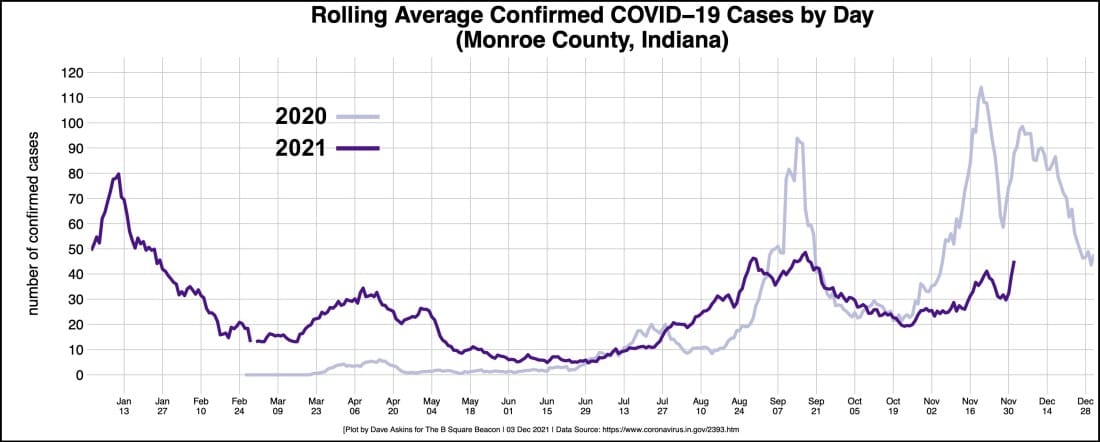Post-Thanksgiving pandemic surge continues in Monroe County: “Vaccinate, vaccinate, vaccinate!”


Indiana University health officer Aaron Carroll’s message on Friday wrapped up like this: “The best thing we can all keep doing is vaccinate, vaccinate, vaccinate!”
Carroll was speaking at Friday’s biweekly press conference on COVID-19 pandemic response held by local city and county leaders.
Vaccination locations are listed out on searchable map maintained by the state’s department of health.
Even on IU’s Bloomington campus, where almost 95 percent of the university population is vaccinated, the positive case tally for the week ending Dec. 1 was 89. That’s about four times the weekly number that the campus was seeing through the month of October.
For all of Monroe County, the weekly total from Nov. 25 through Dec. 1 was 275.
The countywide daily positive case numbers reported for Wednesday and Thursday were 91 and 74. Monroe County has not seen daily case numbers that high since early January.
The gradual decline in positive cases from mid-September through mid-October was replaced by a modest increasing trend, which dipped slightly heading into Thanksgiving. After Thanksgiving, the numbers have shown a sharp rise. It’s the same pattern statewide.
It’s also a similar pattern to last year’s trends, even if the numbers are smaller—just about half the number of cases the county was seeing last year, when no vaccines were available.
In 2020, from Nov. 27 through Dec. 2, the 7-day rolling average of cases rose from 63 to 88, which is about a 40 percent jump.. For the same date range this year, the rolling daily average in Monroe County has climbed 50 percent, from 30 to 45.
Monroe County health administrator Penny Caudill pointed to the countywide vaccination rate—about half the eligible population—as not enough to keep down the rate of community spread. About the county’s vaccination rate, Caudill said, “It is not good. It’s not nearly high enough.”
It’s a low vaccination rate, combined with a failure to execute on some basic preventative measures, that is feeding the recent surge, Caudill said. “Mask wearing indoors and in crowded situations is waning,” Caudill said.
Caudill continued, “And it is clear that people are not staying home when they are sick. If you have a fever, symptoms, you’re not feeling well, please get tested, stay home and away from others.” Caudill added, “Isolating yourself reduces your risk of infecting others around you,” she said.
Caudill cautioned that people who are vaccinated might be incorrectly assuming that their symptoms are just a cold, when in fact it’s COVID-19. For that reason, she encouraged those who are vaccinated to get tested, if they have anything like COVID-19 symptoms.
COVID-19 symptoms include: fever or chills, cough, shortness of breath or difficulty breathing, fatigue, muscle or body aches, headache, new loss of taste or smell, sore throat, congestion or runny nose, nausea or vomiting, and diarrhea.
More evidence of the recent higher prevalence of COVID-19 in the local community comes from the wastewater testing that the city of Bloomington is doing.
At Friday’s news conference, Bloomington mayor John Hamilton reported gene copies of the virus were showing detectable levels in samples taken at both of the city’s plants in the most recent round of testing. In the last seven weeks, levels have been detectable.
In the most recent tests, the number of gene copies per 100ml of wastewater at the Blucher Poole treatment plant rose from 22 on Nov. 22 to 180 gene copies per 100ml on Nov. 29. At the Dillman Road plant, in the same timeframe, the number rose from 140 to 670 per 100ml.






Comments ()